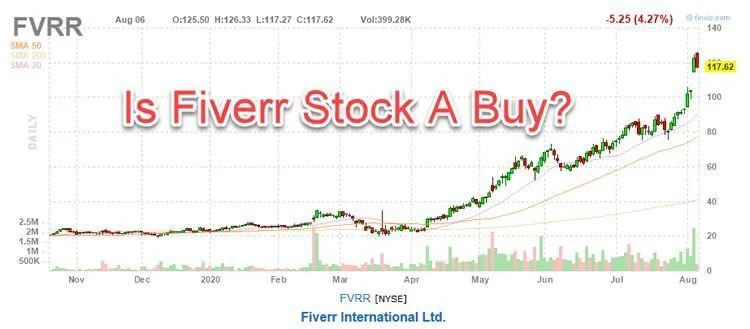Fiverr International Ltd. has become a significant player in the freelance marketplace since its founding in 2010. It connects freelancers offering services, or “gigs,” with businesses and individuals seeking to hire talent. With a broad array of categories ranging from graphic design to digital marketing, Fiverr aims to empower people to do what they love while providing employers with an efficient way to find the resources they need.
Now, when we talk about Fiverr’s stock performance, things have been a bit of a roller coaster ride. After going public through an IPO in 2019, its stock price initially surged. However, like many tech stocks, it faced challenges in subsequent years. Despite a surge in its user base and revenue growth, fluctuations in market sentiment and changing economic conditions have led to declines in its stock valuation. Investors are keeping a close eye on whether Fiverr can rebound and regain its earlier highs, or if it will continue to struggle in a competitive landscape.
Current Market Conditions Affecting Fiverr

The current market landscape is packed with uncertainties that directly impact Fiverr’s stock and overall performance. As we all know, the economy is not static, and a variety of factors play into how companies like Fiverr perform.
Here are some of the key market conditions affecting Fiverr:
- Inflation and Interest Rates: Rising inflation rates have led central banks to increase interest rates, potentially reducing consumer spending. If businesses tighten their budgets, they may hire fewer freelancers.
- Competition: Fiverr faces stiff competition from other platforms like Upwork and Freelancer. Any change in competitive dynamics can influence Fiverr's market share and pricing strategies.
- Market Sentiment: The overall sentiment in the tech stock market has been volatile. Investor confidence can have a significant impact on Fiverr’s stock performance.
- Post-Pandemic Trends: Even though remote work became more prevalent during the pandemic, the future of freelance work remains uncertain as companies begin returning to traditional work structures.
- Regulatory Changes: New regulations affecting digital marketplaces could change how Fiverr does business, impacting profitability and operational flexibility.
In summary, understanding the current economic conditions is crucial for gauging whether Fiverr's stock can find its footing and potentially recover from recent downturns. The interplay between these factors will be central to the company's future trajectory.
Also Read This: How to Become a Seller on Fiverr Mobile App
Historical Performance of Fiverr Stock

Fiverr, the online marketplace for freelancers, has had quite a ride since its initial public offering (IPO) in June 2019. It started trading at a price of around $26 per share, which could be seen as a promising beginning. However, like many tech stocks, it quickly experienced its ups and downs in the volatile market.
In the months following its IPO, Fiverr's stock surged to an all-time high of approximately $339 in February 2021, fueled by the increasing demand for freelance services during the pandemic. People turned to online platforms for work, and businesses sought flexible solutions to adapt to the new normal. But, like many others, Fiverr faced a reality check in 2021, with price corrections leading to a significant drop. As of late 2023, Fiverr's stock is trading below its IPO price, and many investors are left wondering if there’s a way back up.
To better understand Fiverr's historical performance, let’s consider some key points:
- IPO Launch: June 2019 at $26
- Peak Price: $339 in February 2021
- Recent Trajectory: Declined significantly below IPO price
- Market Response: Highly reactive to economic changes, shifts in freelance demand
This historical overview shows that while Fiverr experienced impressive growth during a unique period, external factors and market adjustments have led to significant fluctuations. Investors are curious about whether this stock can regain its momentum moving forward.
Also Read This: How to Make a Gig Active on Fiverr
Factors Influencing Fiverr's Recovery

When looking at whether Fiverr stock can recover, it's vital to examine the various factors at play. Several elements could contribute to a potential rebound in its stock price, and keeping an eye on these can inform investors’ decisions.
1. *Market Demand: The continuous expansion of the gig economy plays a crucial role. As more companies embrace remote work and outsourcing, Fiverr stands to benefit. If the trend persists, it could result in higher revenue, and ultimately, a stock price recovery.
2. Competitive Landscape: Fiverr is not alone in the freelancing space. Competition from platforms like Upwork, Freelancer, and even emerging new apps can influence Fiverr's market share and growth potential. How Fiverr positions itself against this competition will be critical.
3. Innovative Offerings: Continuous evolution of service offerings can also influence Fiverr’s ability to attract new customers. Introducing new features or targeting specific industries could capture more market segments.
4. Economic Factors: Overall economic climate, including inflation rates, interest rates, and consumer spending habits, can greatly affect stock performance. A recovering economy may help ease financial pressures for small businesses, leading to more spending on freelance services.
5. User Experience: Maintaining a seamless and effective user experience is vital. Customer satisfaction leads to repeat business and referrals, which can drive Fiverr's growth.
In summary, while the road to recovery may be complex for Fiverr, keeping an eye on these key factors can provide insights into its future performance and potential for a rebound in stock value.
Also Read This: Why Can’t I Publish My Gig on Fiverr?
Expert Opinions and Analyses

When it comes to stock market investments, expert opinions can provide valuable insights into the viability and potential recovery of a stock like Fiverr. Analysts and market experts often delve deep into both quantitative and qualitative factors, examining financial health, market trends, and overall economic conditions. So, what are they saying about Fiverr? Let's break it down.
1. Earnings Performance: Many analysts have pointed out that Fiverr's quarterly earnings reports show fluctuating revenue growth. While some quarters have exceeded expectations, others have fallen short, leading to a mixed bag of opinions. Continuous monitoring of earnings is essential as it reflects operational efficiency and market demand.
2. Market Trends: The gig economy is under a magnifying glass due to the increasing reliance on freelance work across various industries. Experts argue that if Fiverr can tap into new markets and expand its service offerings, that might provide a pathway for growth.
3. User Growth: Analysts often emphasize the importance of user base expansion. Fiverr needs to retain existing users while also attracting new ones, particularly corporate clients looking for scalable solutions for their project needs.
4. Competitive Landscape*: With the rise of competitors like Upwork and Freelancer, experts suggest that Fiverr should focus on differentiating its platform. Cannibalizing market share is vital, and analysts suggest enhanced marketing strategies and varied service offerings to stand out.
In summary, the outlook on Fiverr stock recovery is a mixture of caution and cautious optimism. Prognosis might vary, but staying informed and taking expert analyses into account is fundamental for any investor.
Also Read This: How to Add a Payment Method on Freelancer
Alternatives to Consider: Investing in Fiverr vs. Competitors
When evaluating whether to invest in Fiverr, it's crucial to consider not just its performance but also similar platforms that vie for the same audience. So, how does Fiverr stack up against its competitors? Let’s explore some alternatives to help you make a more informed decision.
| Platform | Market Position | Unique Features | Target Audience |
|---|---|---|---|
| Fiverr | Solely focused on freelancer services | Gig-based platform with diverse categories | Small to medium businesses, individual entrepreneurs |
| Upwork | Established leader in freelance marketplace | Flexible project contracts, dedicated hiring | Corporations, enterprises seeking long-term contracts |
| Freelancer | Global reach with a large freelancer pool | Allows bidding on projects; contests for design | Wide range from individuals to companies |
When comparing Fiverr with its competitors, remember a few key points:
- Market Positioning: Fiverr caters predominantly to small businesses and individuals, while Upwork often attracts larger corporations.
- Service Variety: Although Fiverr boasts a vast selection of gig services, platforms like Upwork allow for a more customized hiring experience.
- Financial Implications: Investing in Fiverr may offer skyrocketing growth potential but comes with its risks. On the other hand, competitors might provide more stability.
Ultimately, the decision of whether to invest in Fiverr or its competitors should align with your investment goals, risk tolerance, and market outlook. Make sure to weigh your options carefully before pulling the trigger!
Will Fiverr Stock Recover?
Fiverr International Ltd. has gained significant attention as an online marketplace for freelance services, but its stock performance has been a subject of speculation among investors. As we analyze the potential for recovery, it’s essential to consider various factors that influence Fiverr's stock price, including market trends, financial performance, and competition.
Current Market Position
Fiverr operates within the gig economy, which has seen fluctuating demand due to economic changes. Its stock performance can be influenced by:
- Market Demand: Growth in freelance services increases Fiverr's user engagement.
- Investor Sentiment: Analysts’ ratings and market trends can affect stock prices significantly.
Financial Performance
To gauge whether Fiverr's stock will recover, we should review its recent financial metrics:
| Metric | Q1 2023 | Q2 2023 |
|---|---|---|
| Revenue | $80 million | $85 million |
| Net Income | -$5 million | -$2 million |
| Active Buyers | 4 million | 4.5 million |
This data shows some increase in revenue, but negative net income poses concerns for potential investors.
Competitive Landscape
Fiverr faces competition from platforms like Upwork and Freelancer, which can impact its market share. Adapting to new industry trends and customer preferences will be crucial for maintaining a competitive edge.
Conclusion: As Fiverr navigates these challenges, its stock recovery will largely depend on its ability to adapt to market conditions, improve financial metrics, and differentiate itself from competitors. Investors should stay informed and monitor upcoming quarterly reports for clearer insights into Fiverr's trajectory.



